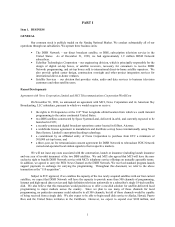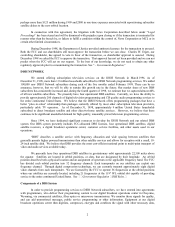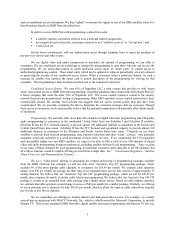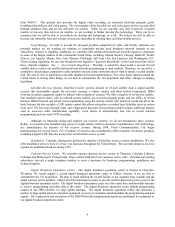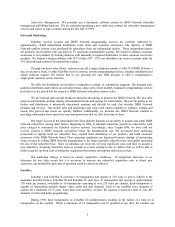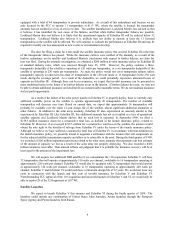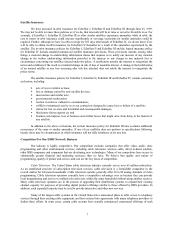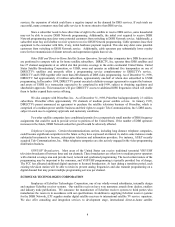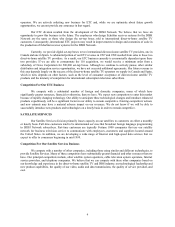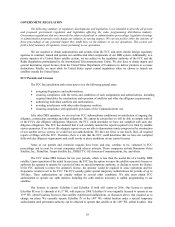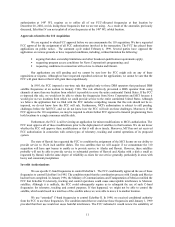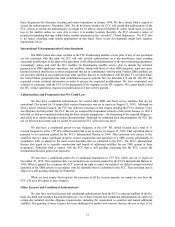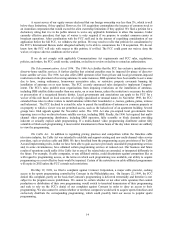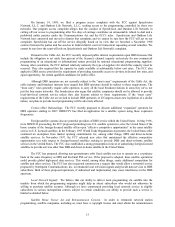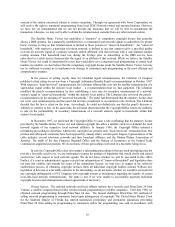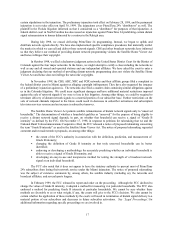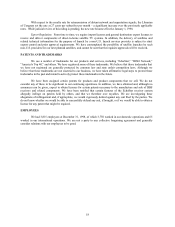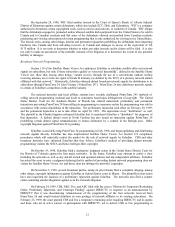Dish Network 1998 Annual Report Download - page 13
Download and view the complete annual report
Please find page 13 of the 1998 Dish Network annual report below. You can navigate through the pages in the report by either clicking on the pages listed below, or by using the keyword search tool below to find specific information within the annual report.11
authorization at 148° WL requires us to utilize all of our FCC-allocated frequencies at that location by
December 20, 2002, or risk losing those frequencies that we are not using. As a result of the anomalies previously
discussed, EchoStar IV can not exploit all of our frequencies at the 148° WL orbital location.
Approvals related to the 110 Acquisition
We are required to obtain FCC approval before we can consummate the 110 acquisition. We have requested
FCC approval for the assignment of all FCC authorizations involved in the transaction. The FCC has placed these
applications on public notice. The comment cycle ended February 4, 1999. Several parties have opposed the
application on various grounds or have requested conditions, including, without limitation the following:
• arguing that alien ownership limitations and other broadcast qualification requirements apply;
• requesting program access conditions for News Corporation’s programming; and
• requesting conditions in connection with service to Alaska and Hawaii.
Our applications are still pending and we cannot be sure how the FCC might rule on any of these
oppositions or requests. Although we have requested expedited action on the applications, we cannot be sure that the
FCC will grant them or that it will grant them expeditiously.
In 1995, the FCC imposed a one-time rule that applied only to those DBS operators that purchased DBS
satellite frequencies at an auction in January 1996. The rule effectively prevented a DBS operator from using
channels at more than one location from which it is possible to serve the entire continental United States. If the FCC
re-imposed this rule, we would not be able to obtain the frequencies from News Corporation and MCI because it
would give us two locations from which we could provide service to the entire continental United States. Although
we believe the application that we filed with the FCC includes compelling reasons that this rule should not be re-
imposed, we do not know how the FCC will rule. Furthermore, MCI’s authorization is subject to still pending
challenges before the full FCC, and we do not know how the FCC will rule on these challenges. Moreover, if the
FCC approves the 110 acquisition, we may be required to obtain further FCC approval to transmit programming from
both locations to a single consumer satellite dish.
Furthermore, the FCC is still reviewing an application for minor modifications to MCI’s authorization. The
FCC must approve all of these modifications prior to the deployment of satellites to that location. We do not know
whether the FCC will approve these modifications or that it will do so timely. Moreover, MCI has not yet received
FCC authorization in connection with certain types of telemetry, tracking and control operations of its proposed
system.
The state of Hawaii has requested the FCC to condition the assignment of the MCI license on our ability to
provide service to 18-24 inch satellite dishes. The two satellites that we will acquire if we consummate the 110
acquisition will have spot beams to enable us to provide service to Alaska and Hawaii. However, these satellites
probably will not be able to provide service to substantial portions of Hawaii and Alaska with a dish a small as
requested by Hawaii with the same degree of reliability as exists for our service generally, particularly in areas with
heavy and consistent precipitation.
In-orbit Authorizations
We use specific C-band frequencies to control EchoStar I. The FCC conditionally approved the use of these
frequencies to control EchoStar I in 1995. The condition stated that the coordination process with Canada and Mexico
had not been completed. In January 1996, the Ministry of Communications and Transportation of Mexico notified the
FCC that EchoStar I’s telemetry, tracking and control operations could cause unacceptable interference to Mexican
satellites. Although it is unlikely, the FCC could subsequently require us to relinquish the use of such C-band
frequencies for telemetry, tracking and control purposes. If that happened, we might not be able to control the
satellite, which could result in a total loss of the satellite unless we were able to move it to another location.
We use “extended” C-band frequencies to control EchoStar II. In 1996, we received conditional authority
from the FCC to use these frequencies. The condition stated that we could use those frequencies until January 1, 1999
provided that their use would not cause harmful interference. The FCC indicated it would review the suitability of


